
Daucus carota, whose common names include wild carrot, European wild carrot, bird's nest, bishop's lace, and Queen Anne's lace, is a flowering plant in the family Apiaceae. It is native to temperate regions of the Old World and was naturalized in the New World.

Maianthemum racemosum, the treacleberry, feathery false lily of the valley, false Solomon's seal, Solomon's plume or false spikenard, is a species of flowering plant native to North America. It is a common, widespread plant with numerous common names and synonyms, known from every US state except Hawaii, and from every Canadian province and territory, as well as from Mexico.
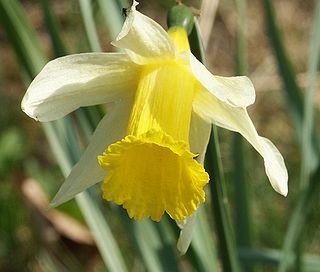
Narcissus pseudonarcissus, commonly named the wild daffodil or Lent lily, is a perennial flowering plant.
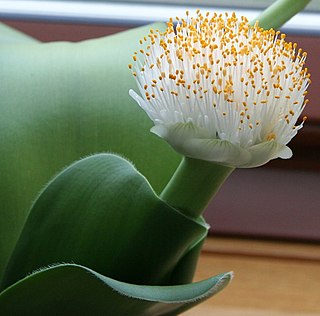
Haemanthus is a Southern African genus of flowering plants in the family Amaryllidaceae, subfamily Amaryllidoideae. Members of the genus are known as blood lily and paintbrush lily. There are some 22 known species, native to South Africa, Botswana, Namibia, Lesotho and Eswatini. About 15 species occur in the winter rainfall region of Namaqualand and the Western Cape, the remainder being found in the summer rainfall region, with one species Haemanthus albiflos occurring in both regions.

Scadoxus puniceus, commonly known as the paintbrush lily, is a species of bulbous plant. It is native to much of southern and eastern Africa: Ethiopia, Sudan, Tanzania, Malawi, Mozambique, Zambia, Zimbabwe, Botswana, Eswatini (Swaziland), and South Africa. Scadoxus puniceus can be found in cool, shady habitat such as ravines and forests, where it is often found in moist leaf litter. Other common names include snake lily, royal paintbrush, King-of-Candida, African blood lily (English), rooikwas (Afrikaans), isisphompho, and umgola (Zulu). There are nine species of Scadoxus of which three, S. puniceus, S. multiflorus and S.membranaceus, occur in South Africa.

Crinum asiaticum, commonly known as poison bulb, giant crinum lily, grand crinum lily, or spider lily, is a plant species widely planted in many warmer regions as an ornamental. It is a bulb-forming perennial producing an umbel of large, showy flowers that are prized by gardeners. However, all parts of the plant are poisonous if ingested. Some reports indicate exposure to the sap may cause skin irritation.

Scadoxus is a genus of African and Arabian plants in the Amaryllis family, subfamily Amaryllidoideae. The English names blood lily or blood flower are used for some of the species. The genus has close affinities with Haemanthus. Species of Scadoxus are grown as ornamental plants for their brilliantly coloured flowers, either in containers or in the ground in frost-free climates. Although some species have been used in traditional medicine, they contain poisonous alkaloids.

Scadoxus cyrtanthiflorus is a herbaceous plant endemic to the Rwenzori Mountains of east tropical Africa. Unusually for the genus Scadoxus its tubular blooms are pendant. It is sometimes grown as an ornamental plant in heated greenhouses.
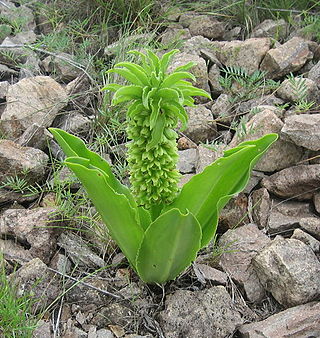
Eucomis autumnalis, the autumn pineapple flower, or autumn pineapple lily, is a species of flowering plant in the family Asparagaceae, subfamily Scilloideae, native to Malawi, Zimbabwe and southern Africa. It is a mid to late summer flowering deciduous bulbous perennial. The flower stem reaches about 40 cm (16 in), rising from a basal rosette of wavy-edged leaves. The green, yellow or white flowers are arranged in a spike (raceme), topped by a "head" of green leaflike bracts. It is grown as an ornamental garden plant and can also be used as a cut flower.
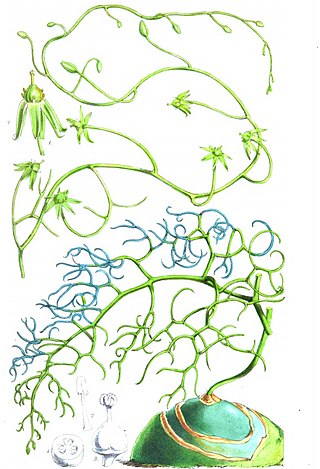
Bowiea, commonly known as climbing-onion, is a genus of bulbous, perennial, succulent plants which thrive in dry and desert regions of eastern and southern Africa, ranging from Uganda to South Africa. It is native to a region stretching from Kenya to Cape Province. It is the 14th most commonly sold medicinal plant in South Africa, used to treat various health conditions. Due to massive harvesting, populations of this plant have been significantly reduced. Because of its high content of potent cardiac glycosides, it is highly poisonous, and deaths of humans and other animals after ingestion are attributed to cardiac arrest. Due to its unique appearance, it is cultivated as a houseplant.
Blood lily is a common name for several plants and may refer to:
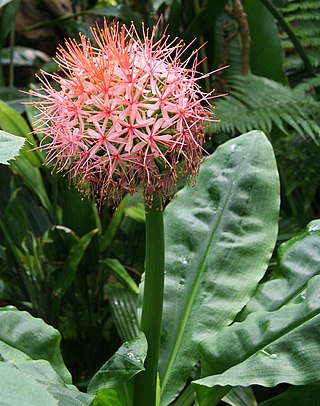
Scadoxus cinnabarinus is a herbaceous plant from tropical rainforest in Africa. It is native to Western and Central Africa from Sierra Leone in the far west to Angola in the south. It has been reported from Ghana, Côte d'Ivoire, Nigeria, Niger, Sierra Leone, Central African Republic, Cameroon, Congo, Equatorial Guinea, Gabon, São Tomé, Zaire, Uganda, and Angola.
Scadoxus longifolius is a herbaceous plant from Zaire. It is only known from a single collection, and little information is available about it. It appears to be closely related to Scadoxus cinnabarinus, and Inger Nordal and Thomas Duncan suggested in 1984 that it may not be a distinct species.

Scadoxus membranaceus is a flowering plant in the Amaryllidaceae family. It is a bulbous plant from South Africa. The smallest of the species of Scadoxus, it is sometimes cultivated as an ornamental plant where a minimum temperature of 5 °C (41 °F) can be maintained.
Scadoxus nutans is a herbaceous plant endemic to southwest Ethiopia. Its red to pink flowers face downwards as the top of the flowering stem bends over, unlike any of the other species of Scadoxus. It grows mainly as an epiphyte in tropical mountain forests, which are disappearing, making the species vulnerable to extinction. It is sometimes cultivated as an ornamental plant.

Scadoxus pole-evansii, commonly known as the Inyanga fireball, is a herbaceous plant endemic to mountains in east Zimbabwe. It was only discovered for science in 1960. Similar in many respects to the more widely grown Scadoxus multiflorus, it is cultivated as an ornamental plant.
Scadoxus pseudocaulus is a herbaceous plant native to Nigeria, Equatorial Guinea, Cameroon and Gabon. Similar in many respects to Scadoxus cinnabarinus, it is cultivated as an ornamental plant but has proved reluctant to flower.

Leucojum aestivum, commonly called the summer snowflake, giant snowflake, Loddon lily and rarely snowbell and dewdrop among others, is a plant species widely cultivated as an ornamental. It is native to most of Europe from Spain and Ireland to Ukraine, with the exception of Scandinavia, Russia, Belarus and the Baltic countries. It is also considered native to Turkey, Iran and the Caucasus. It is naturalized in Denmark, South Australia, New South Wales, Nova Scotia and much of the eastern United States.
Strumaria discifera is a species of flowering plant in the family Amaryllidaceae, native to west and south-west Cape Provinces. It was first described in 1992.

















